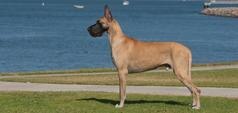
The Foundation of Smart Breeding Is Through Healthy Nutrition

Proper nutrition for a female dog before breeding is crucial for successful whelping. Veterinary nutritionists and reproduction specialists emphasize that maintaining a healthy body condition significantly affects reproductive outcomes.
Andrea Hesser, DVM, DACT, a board-certified theriogenologist who practices at Josey Ranch Pet Hospital in Carrollton, Texas, says, “An ideal body condition of 5 or 6 out of 9 is optimal for conception, healthy pregnancy, delivery, and lactation.”
Alternatively, a female having a thin body condition may not cycle normally, and one in an overly thin state may have limited ability to conceive. “Reproduction is a ‘low-priority’ body function in thin animals,” Dr. Hesser explains. “If a dog’s nutritional needs are not met, the uterus and ovaries are less active. When a thin female dog cycles, the nutrients such as fat that are required to form healthy eggs and later embryos may be of low quality and less likely to result in puppies.”
Obesity presents other complications related to conceiving and carrying a pregnancy to term. “Females in obese body condition have more pelvic fat, which prevents puppies from easily passing out of the pelvis during delivery,” says Dr. Hesser. “Adipose tissue, or fat, is a source of inflammation for the body, and this inflammatory state is not optimal for a female dog and likely is part of the reason we see decreased conception rates in overweight female dogs.”
Maintenance of ideal body condition is important throughout the nine weeks of pregnancy. “Regardless of the phase of pregnancy, diets should be adjusted based on maintaining ideal body condition for the pregnant dam,” says Purina Senior Research Nutritionist Deborah Greco, DVM, PhD, DACVIM. “Ideal body condition during pregnancy is defined as having an appropriate muscle and fat balance. You should be able to easily feel her ribs, shoulder blades and hips; however, her growing abdomen means that you cannot see a waist behind the ribs when viewing from the top or an abdominal tuck from the side as when she is not pregnant.”
During the first trimester (0-21 days), a dam should continue to be fed her regular adult or all life stages dog food. In the second trimester (22-42 days), gradually increase the amount of food, preferably an all life stages or puppy food, based on individual nutritional needs. In the third trimester (43-64 days), adjust the diet to meet the dog's nutritional requirements, typically feeding 1.5 times more food than before pregnancy in small, frequent meals throughout the day.
As fetal development continues, the dam has progressively less abdominal space for comfortable digestive tract expansion and function. To accommodate this, it is recommended to feed the dam frequent smaller meals. The growing fetuses, fluid, developing placental tissues, and mammary glands contribute to the dam's increasing body weight. In the final two weeks of gestation, it's common for food consumption to increase.
“The importance of feeding a balanced commercial all life stages dog food or puppy food as the mainstay for optimal reproductive capacity in females and optimal growth in puppies is key,” Dr. Greco says. “Certain micronutrients and macronutrients, when balanced with other nutrients in the formulation, can affect the long-term health and well-being of puppies. Optimal nutrition is so important during pregnancy and lactation for the dam and her puppies.”
NUTRITION FOR PREGNANCY & LACTATION
- Female dogs should be fed a caloric-dense dog food during pregnancy and lactation. Veterinary nutritionists recommend feeding an all life stages dog food or a puppy food providing 400 to 500 kilocalories. It is ideal to feed a highly palatable food that provides complete and balanced nutrition, including a proper balance of carbohydrates, which are so important for a healthy pregnancy.
- A high protein-to-fat ratio around 30 percent protein and 20 percent fat is recommended. A protein deficiency during pregnancy can reduce the birth weight of puppies and increase neonatal mortality. Protein requirements are even higher during lactation, especially in large litters. Fat contains twice as much energy, or kilocalories, per unit of food than carbohydrates or protein, making it an essential part of nutrition for gestation and lactation.
- The quantity of food fed should not be increased during the first trimester, or three weeks, of pregnancy. During the second trimester, the amount of food fed should be gradually increased. A pregnant female’s intake requirements generally increase one and a half times more than maintenance during the last trimester, though this varies based on the nutritional needs of an individual female dog. Several small meals a day are recommended due to less abdominal space related to pregnancy.
- Females with average size litters should gain no more than 15 to 25 percent of their pre-pregnancy body weight and weigh 5 to 10 percent more than their pre-pregnancy weight immediately after whelping.
- Energy requirements may increase by double to triple during lactation, particularly with large litters. Female dogs carrying singleton or small litters may not need an increase in calories despite increased appetite.
Purina® Pro Plan® is the #1 brand most fed and recommended brand by dog breeders in Canada.* Learn more about the what the Pro Club Breeder program has to offer, including up to 25% savings on Pro Plan dog and puppy food, a free bag of puppy food for your new pet owners and more!
*Canadian Dog Fancier survey results, November 2023
Related articles


